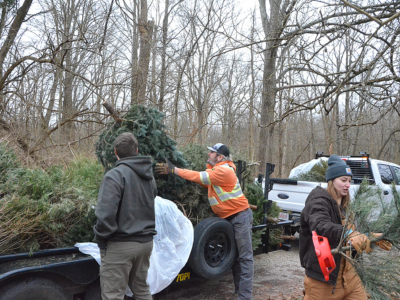EPA cites Morris Bean for discharge
- Published: October 3, 2013
Morris Bean & Company will soon bid out a project to fill in a sinkhole at its Hyde Road plant after the Ohio Environmental Protection Agency cited the company for releasing industrial wastewater into the sinkhole and potentially contaminating groundwater in the Village’s source water protection area.
During a routine inspection in May the Ohio EPA Division of Surface Water found that industrial wastewater in a pond at the foundry was discharging into a newly-formed sinkhole on the southeast corner of the property rather than a surface water pathway as permitted. According to the Ohio EPA, which issued the violation in June, the sinkhole likely formed naturally due to the local geology. The Ohio EPA’s last inspection of the area was in 2006, according to Ohio EPA spokesperson Heather Lauer.
However, neither the Ohio EPA nor the Ohio Department of Natural Resources believe that Morris Bean’s plan to fill in the sinkhole will be a permanent solution because the bedrock is prone to fractures that allow water on the surface to quickly enter the groundwater, Lauer said this week.
“We told Morris Bean that this [plan] is fine as long as it holds,” Lauer said. “But based upon the geology out there we don’t think it will be their permanent solution.”
Last September, Morris Bean received a NPDES (National Pollutant Discharge Elimination System) permit to release treated process water and non-contact cooling water from its onsite pond into an unnamed stream that passes through the Glen Helen Nature Preserve and 2.5 acres of restored wetland before it enters the Little Miami River.
Discharging the wastewater into a sinkhole violated Morris Bean’s NPDES permit because the wastewater was pouring directly into the groundwater, which is the source of the Village’s municipal water supply, rather than into the stream. Morris Bean is located about one-half mile north of the Village well field and is within a five-year time-of-travel to the Village’s wells.
In initial water sampling of the wastewater entering the sinkhole, the Ohio EPA detected no toxic chemicals or other parameters limited by their permit, Lauer said. According to Morris Bean Vice President Bill Magro in an email this week, the company has been discharging that wastewater for at least the last 60 years.
Lauer added that while there is no immediate threat to Village water supplies, the Village should take steps to cooperate with Morris Bean to address several potential pollution threats at the company. In addition to the recent violation, Morris Bean has yet to replace an outdated on-site sewage treatment system, which the Ohio EPA has previously identified as a potential pollution source to the wellfield.
“There’s no indication that there’s anything from this that’s getting into the wellfield, but Yellow Springs recognizes that [Morris Bean] is in a sensitive area,” Lauer said. “Really it would be great if you could come together and make sure both sides are doing what they can.”
Morris Bean’s proposed plan to prevent wastewater from entering the sinkhole includes excavating the area near the sinkhole, plugging holes in the bedrock with stones of various sizes, installing a layer of bentonite clay, and covering the hole with at least six inches of soil. The Ohio EPA additionally requested that a sewer camera be used before the excavation to determine the extent of the sinkhole, Lauer said.
Morris Bean will soon bid out the project, according to Magro.
Morris Bean, an aluminum casting foundry, has operated at its 60-acre property at 777 East Hyde Road in Miami Township since 1949.
Toxic clean-up complete
An unrelated groundwater contamination remediation project at Morris Bean came to an end in 2011, when the Ohio EPA officially terminated its clean-up order. From 2000 to 2009 Morris Bean pumped and treated its contaminated groundwater under order from Ohio EPA after volatile organic compounds, or VOCs, including the contaminant 1,1-dichloroethane, were detected in 1988 in Village production and monitoring wells and in springs in the Glen Helen Nature Preserve. The contaminants were never found in the Village’s treated water, according to the 2001 Village Wellhead Protection Management Plan. After Morris Bean closed down its pump-and-treat system in early 2009 and met Ohio EPA standards for groundwater quality for eight consecutive quarters, the clean-up order was terminated.
It was determined that the contaminant 1,1-dichloroethane is a degradation product of another chemical, 1,1,1-trichloroethane, which Morris Bean used until 1991 to facilitate the removal of its sand aluminum casting molds. However, the source of the contamination was never found. Groundwater at Morris Bean was also found to contain 1,1,1-trichloroethane, 1,1-dichloroethene, and 1,2-dichloroethene.
According to Village water and wastewater superintendent Joe Bates this week, the Village is not currently testing for VOCs because it is not an annual Ohio EPA requirement, but the Village has tested for them in recent years due to citizen concerns. The most recent test for VOCs, in December 2012, showed that the VOC 1,1-dichloroethane was detected in raw water in well number 1, which the village currently only uses as a monitoring well. The level of 1,1-dichloroethane measured was 0.810 parts per billion, far below the EPA’s maximum contaminant level for of 5.0 parts per billion, according to the Village’s 2012 Consumer Confidence Report.
Sewage issue unresolved
Another potential pollution source at Morris Bean has yet to be addressed. Since the late 1990s, the Ohio EPA has recommended that Morris Bean either upgrade its inefficient on-site biological sewage treatment plant and pond, which might be a source of contamination to the Village well field, or tie into the Village’s sewer. The Village agreed to connect Morris Bean to its sewer system in a 2010 resolution, but after funding was lost for the project and the Village re-affirmed that it would not extend utilities outside its borders without annexing, the project was canceled.
According to Magro, Morris Bean is exploring options for replacing its sanitary sewage treatment system, with input from the Ohio EPA. Previously the company worked for eight years to connect to the Village’s sewer system in what was seen as beneficial for both Morris Bean and the community, but that “various changes have impeded progress towards what was considered a worthwhile goal,” he wrote.
Funding for the sewer connection project was to come from a 2006 federal earmark of $119,500 and a match from Morris Bean. However, when that earmark was rescinded in 2010 and the state began to cut local government funding, the “economic landscape changed” and the Village began to reconsider the project, according to Village Solicitor Chris Conard.
Since Morris Bean is in Miami Township, the Village initially made an exception in a 2005 Village resolution to its policy to not extend utilities beyond the village because of the threat of contamination to Village water supplies. However, the Village is not aware of any immediate threat to the watershed from Morris Bean’s sewage treatment plant, Conard said.
“The environmental concern was very important to us, but that’s why you have the federal and state EPA,” Conard said. “I don’t believe that Council or the Village Manager felt that there would be any increased threat to the environment.”
Village Manager Laura Curliss added in a recent interview that Council twice in recent years affirmed through legislation that the Village would not extend utilities beyond its borders without annexing, a policy that dates back to 1992. Even with a 100 percent surcharge in utility fees for those outside the village, a policy enacted last year, the Village would not recoup its costs to provide such services, Curliss said. Instead, tax dollars from those residing or doing business in the Village are needed to cover the Village’s overhead, she said.
While the Ohio EPA has identified the sewage treatment plant as a potential pollution source on numerous occasions, the plant has continued to pass annual inspections by the Greene County Combined Health District, which has contracts with the Ohio EPA to oversee sanitary sewer permits for industries. According to Mark Issaacson, program manager for the health district, at the last inspection in December 2012, the plant was emitting some effluent and there was an odor, but there were no visible concerns. The health department is only looking for obvious problems that can be easily seen, he added.
In a July letter to Curliss, Mike Proffit, assistant division chief of the Southwest Ohio District of the Ohio EPA, strongly urged the Village to cooperate with Morris Bean to address potential pollution threats from the foundry because Yellow Springs’ water is highly susceptible to contamination. Among the factors that make the Village’s water vulnerable, according to Proffit, are that there is no geologic barrier to contamination between the surface and underground aquifer, the depth to water is shallow, there are potential contaminant sources in the source water protection area and there have been ongoing detections of volatile organic compounds, or VOCs, in the Village’s raw water. Proffit wrote:
“Ohio EPA strongly encourages the Village to implement their [Wellhead Protection] Plan and continue their dialog with Morris Bean on the best possible options to protect their drinking water source.”
The Yellow Springs News encourages respectful discussion of this article.
You must login to post a comment.
Don't have a login? Register for a free YSNews.com account.

Parkinsons.jpg)













No comments yet for this article.